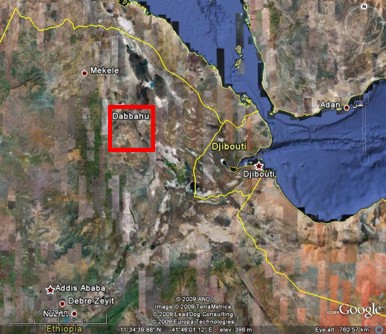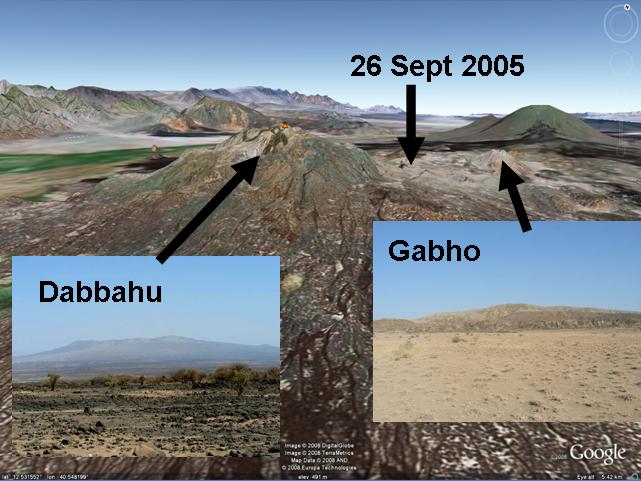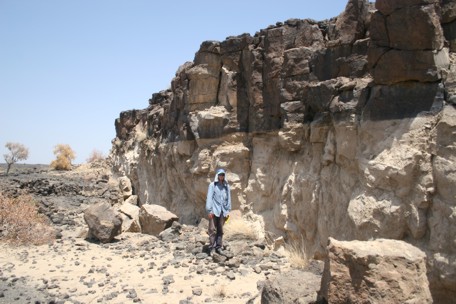
Map of the Afar region showing the location of the Dabbahu magmatic segment.
Dabbahu Magmatic Segment
The Dabbahu magmatic segment is about 60km long and 15km wide with the Dabbahu and Gab’ho volcanoes at the northern end and the Ado’Ale volcanic complex at the southern end. Figure 5 shows a series of Google Earth images of the Dabbahu magmatic segment and the dyking event in September 2005.
Dabbahu volcano is 1350m above sea level and about 10km diameter. To the northwest are a line of smaller volcanoes and cinder cones (photo 1) and to the south is a well developed rift valley which decreases in size towards Ado’Ale. The Ado’Ale volcanic complex covers a wide area of the central Dabbahu magmatic segment and is over 750m above sea level. To the south of Ado’Ale the elevation of the rift zone drops beneath the regional level.
The Dabbahu magmatic segment is about 2000km2 in area and 1200 distinct faults/faulted fissures have been mapped across it using satellite data.

3D view of Dabbahu and Gab'ho volcanoes with the location of the September 2005 dyke intrusion
In the north of the segment faults lie north-south, oblique to the extension direction. To the south of Ado’Ale faults strike closer to northwest-southeast and perpendicular to the extension direction. The mean length of individual faults is 1.9km but the faults are link up to form fault zones up to 20km in length. Whilst most faults dip towards the central rift, some dip in the opposite direction giving blocks of higher and lower ground across the segment flanks. Within the 7km area of the central rift axis, the faults and fissures are closely spaced, less than 500m apart and cover the same area as the youngest basaltic lava flows. The faults are close to vertical at the surface having formed by the opening up of pre-existing cooling joints in the older lavas. The have vertical offsets of up to 20m and horizontal offsets of 1-3m.

The light coloured sediment on the fault surface is sediment that has not yet been weathered away by the wind and so acts as a way of assessing the relative age of surface features. The aeolian sediment has settled in cracks in the ground, usually cooling joints within basalt. When these joints are uplifted during faulting the pale sediment is exposed. Over time it will be weathered away by the same katabatic winds from the highlands that deposited it, leaving the dark coloured, older fault scarp. Photograph by Julie Rowland, University of Auckland.
Deep cracks occur along the fault and in some cases these have been used by magmas as channels to the surface. Although the faults are near vertical at the surface they are less steep at depth as show by the development of curved layers of rock above the fault (photo 2). The layers beneath the fault are generally undeformed.
Field observations of structures associated with the seismic event in September 2005 correlate with the distribution of recorded earthquakes and are consistent with the intrusion of a dyke to depths greater than 2.5km. If the September 2005 is a typical rifting event with typical fault growth then the minimum number of such events needed to account for the current rift geomorphology can be estimated. This is about 400 rifting events which together with the time average opening rate of 16mmyr-1 gives a minimum of about 200 thousand years for the topography of the rift segment to develop.
For references used, please see the technical version.
